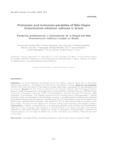Please use this identifier to cite or link to this item:
http://www.alice.cnptia.embrapa.br/alice/handle/doc/1073885| Title: | Protozoan and metazoan parasites of Nile tilapia Oreochromis niloticus cultured in Brazil. |
| Authors: | PANTOJA, W. M. F.  NEVES, L.   DIAS, M. R.   MARINHO, R. G. B.   MONTAGNER, D.   TAVARES-DIAS, M.   |
| Affiliation: | WANDERSON MICHEL FARIAS PANTOJA LIGIA NEVES MÁRCIA KELLY REIS DIAS, UNIVERSIDADE FEDERAL DO AMAPÁ RENATA DAS GRAÇAS BARBOSA MARINHO, UNIVERSIDADE FEDERAL DO AMAPÁ DANIEL MONTAGNER, CPAF-AP MARCOS TAVARES DIAS, CPAF-AP. |
| Date Issued: | 2012 |
| Citation: | Revista MVZ Córdoba, v. 17, n. 1, p. 2812-2819, 2012. |
| Description: | This study describes the parasitic fauna and relative condition factor (Kn) in Nile tilapia Oreochromis niloticus L. (Cichlidae) from fish farms in the State of Amapá. Material and methods. 123 fish from four fish farms in the state of Amapá, Brazil were necropsied for parasitological and Kn analysis. Results. 64.2% of the examined fish, had the gills infected with Cichlidogyrus tilapiae Paperna, 1960 (Monogenoidea: Dactylogyridae); Ichthyophthirius multifiliis Fouquet, 1876 (Protozoa: Ciliophora), Trichodina Ehrenberg, 1830 and Paratrichodina africana Kazubski & El-Tantawy, 1986 (Protozoa: Trichodinidae). The highest prevalence found corresponded to Monogenoidea C. tilapiae while the lowest corresponded to Trichodinidae. However, I. multifiliis was the parasite that presented the greatest intensity and abundance. The differences found in the infection rates of the different fish farms due to causes further discussed. The parasitism did not influence the relative condition factor (Kn) of fish. This was the first record of P. africana in Brazil and occurred in the Eastern Amazon. Conclusions. In Brazil, Lamproglena sp. is an emerging parasite in the Southern and Southeastern regions, but this crustacean was not found in the Nile tilapia in the State of Amapá. The parasitic infections in Nile tilapia farmed in Brazil are caused by protozoan, monogenoidea, crustacea and digenea species, and the regional differences on their prevalence and intensity rates are discussed in this study. |
| Thesagro: | Peixe de água doce |
| Keywords: | Parasito animal Animal parasite Freshwater fishe |
| DOI: | https://doi.org/10.21897/rmvz.248 |
| Type of Material: | Artigo de periódico |
| Access: | openAccess |
| Appears in Collections: | Artigo em periódico indexado (CPAF-AP)  |
Files in This Item:
| File | Description | Size | Format | |
|---|---|---|---|---|
| AP2012ProtozoanandmetazoanparasiteTilapia.pdf | 714.95 kB | Adobe PDF |  View/Open |









